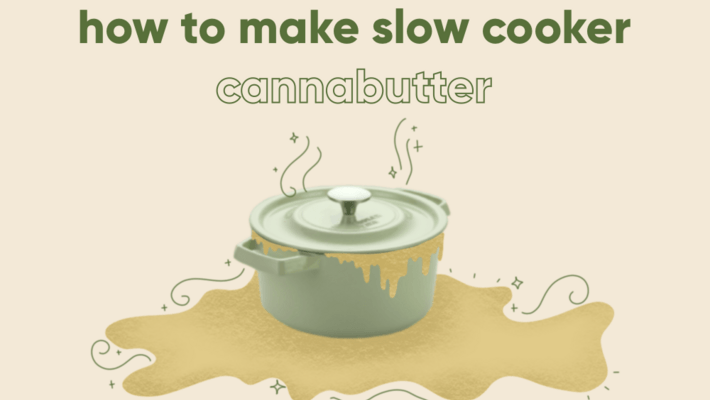
How to Make Slow Cooker Cannabutter: Marijuana Recipes
Published on 1/21/21
With the shift towards being at home more often, people have been cooking like never before. With this uptick in cooking, why not have some fun with it and include your favorite herb? There are many ways to incorporate cannabis into food, but we're going to dive into the world of slow cooker cannabutter and answer your questions about tips for dosing your edibles and how long to cook cannabutter in a slow cooker.
What is Cannabutter?

As one could likely guess, cannabutter is when you infuse cannabis and butter. The primary use of cannabutter is to make edibles, especially baked goods such as brownies, cookies and rice crispy treats. One can infuse cannabutter with only CBD, both CBD and THC or just simply THC. It is up to the creator to decide what effect you're trying to get from your edibles, as the options are endless.
Cannabutter is a great option for those who are looking for smoke-free alternatives. Those in the medicinal, elderly and athletic community may turn to this type of consumption because cannabutter still produces the effects as smoking. Additionally, it still aids in sleep quality, pain management and inflammation, while giving you those famous euphoric feelings.
What is Decarboxylation and Why Does it Matter?
Even though you can purchase cannabutter from your local dispensary, some people like the idea of taking the challenge upon themselves to create cannabutter. For a cannabutter recipe to work, the decarboxylation process is paramount for how to make edibles potent. Before this process occurs, raw cannabis will not give intoxicating effects.
As we know, there are 144 active chemicals in cannabis, called cannabinoids. Decarboxylation is a key reaction of transforming acidic forms of cannabinoids into their "neutral forms", which is how we consume them. To create our beloved THC, this process of decarboxylation occurs with heat, light or oxidation. Through heat, your THCA transforms into THC from the mother CBG, which is where we get our psychoactive feelings from. Therefore, the best cannabutter recipe will include decarboxylation, or you won't be feeling much.
Dosing for Cannabutter
 Unsplash
UnsplashYou may have a pot butter recipe, but how much cannabis is enough cannabis to feel great without that overpowering high feeling? Dosing is the tricky part of edible production, and while it may never be completely right, there are a few tips and tricks and also things to avoid when thinking about your cannabis dosing.
To begin with, know the potency and weight of your THC, CBD, or whatever it is that you're using. It's also important to remember that flower is so much more potent than it used to be. In general, the recommended dose for edibles is 1 to 5 milligrams of THC. This small dosage is perfect for those who are new to edibles, but even those who are familiar will still feel the effects of a dosage like this. Typically, most people use anywhere between 5-20 milligrams, with 10 milligrams being the average edible dosage.
A Rule of Thumb: Be Conservative
When thinking about how to make cannabutter, always err on the side of caution. It is safe to assume that your decarb rate will be 90% of THCA into THC. Also be conservative when thinking of extraction efficiency, as this will come after you have calculated the decarb rate. You don't want any bad surprises, so assume that you will extract a minimum of 60% of THC from the plant.
Make sure you've thoroughly mixed your cannabutter once it's finished so you will keep an even distribution of cannabis throughout. If you're not mixing well, there will be an unequal distribution of your product.
Some other tips include acting as your own guinea pig (if you dare), thinking about your recipe on a "per serving basis", and when in doubt, apply after baking. This can include melting it or drizzling it onto the food item of your choice. When in doubt, the web has numerous calculators for those who need a little extra aid.
Cannabutter Slow Cooker Recipe
 Unsplash
Unsplash- When thinking about your ingredients, there is no need to use your top-shelf bud. Even though potency is still relevant, trimmings and lesser quality cannabis is perfectly fine here. You'll want to use about 8 grams of weed, which will come out to about 2 cups (once ground/decarboxylated).
- Preheat the oven to 245 degrees Fahrenheit and place the bud on a cookie sheet that has some sort of method to prevent sticking. Whichever way you prefer to make the cookie sheet non-stick is fine.
- Place the cookie sheet in the oven for 30-40 minutes. Drier cannabis will take less time in the oven than fresh cannabis. Shake the tray every 10 minutes or so to ensure that it heats evenly, this is the decarboxylation process we spoke of earlier.
- Take the bud out of the oven and grind the flower, with a manual or a hand grinder preferably.
- Set your slow cooker to low (approx. 160 degrees). Make sure it doesn't get over 200 degrees, or the cannabutter may burn.
- Add the cannabis and about 2 cups of unsalted butter.
- Let it sit and stir occasionally. If you're wondering, "how long you should slow cook cannabutter?", the answer is about three hours. If you're worried about burning, add a bit of water to the mix.
- Once done, allow it to cool, as it will separate fats to the top of the slow cooker.
- Strain out the cannabutter.
- Dose any recipe to your liking.
Have you made cannabis edibles before? Do you have any tips and tricks not listed above? Let us know below.
